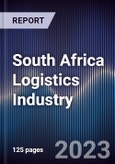The report provides a comprehensive analysis of the potential of Logistics Industry in South Africa. The report covers an overview and genesis of the industry, market size in terms of revenue generated.
The report has market segmentation which include segments by service mix, by mode of freight, by mode of transport, by end users, by type of warehouse, by shipments, and more; growth enablers and drivers; challenges and bottlenecks; trends driving adoption trends; regulatory framework; end-user analysis, industry analysis, competitive landscape including competition scenario and market shares of major players. The report concludes with future market projections of each market segmentation and analyst recommendations.
The report has market segmentation which include segments by service mix, by mode of freight, by mode of transport, by end users, by type of warehouse, by shipments, and more; growth enablers and drivers; challenges and bottlenecks; trends driving adoption trends; regulatory framework; end-user analysis, industry analysis, competitive landscape including competition scenario and market shares of major players. The report concludes with future market projections of each market segmentation and analyst recommendations.
Market Overview:
According to publisher estimates, the Market Size of South Africa Logistics has shown increasing trend from 2017 to 2022. The South African logistics sector supports the second-largest economy on the continent, and is relatively sophisticated. Local and international companies use South Africa as gateway for their operations into Africa. The logistics operators are making significant investments in automation and digitalization in order to address security concerns, improve loss prevention as well as efficiency.- Under National Infrastructure Plan 2050, South Africa will gain from foreign infrastructure investment in Africa which will create friendly logistics system in the country
- Delivery by drone is the new trend in supply chain, South Africa’s startup Flying Labs is introducing cargo drone for faster delivery of medical products in the remote parts of South Africa
Key Trends by Market Segment:
- By Mode of Transport: Sea Freight dominates the Freight Market contributed highest owing to the affordability and accessibility of using sea freight players
- By Warehouse Business Model: Industrial/ Retail Warehouses dominated the South Africa Warehouse market in 2021 by capturing maximum Mn sqm
Future Outlook:
Market Size of South Africa Logistics is expected to show increasing trend from 2022 to 2027. This is owing to National Infrastructure Plan 2050. Delivery by drone is the new trend in supply chain, South Africa’s startup Flying Labs is introducing cargo drone for faster delivery of medical products in the remote parts of South Africa. Also, Value-added services are expected to increase due to the increase in CEP and E-commerce and Warehousing services where VAS such as sorting, and packaging are used.
Additional benefits of purchasing an enterprise license:
- TAM/SAM/SOM Analysis
- Customer Cohort Analysis
- Marketing Initiatives
- White Space Opportunity Analysis
- Interactive Data Visualizations
- Customization: 20 Analyst Hours
- 3 Months Post Sales Analyst Support
- Complimentary Update Next Year
- Custom Webinars
Table of Contents
1. South Africa Country Overview and Import/ Export Scenario
2. Infrastructure Scenario in South Africa
3. South Africa Logistics Market
4. South Africa Freight Market
5. South Africa Warehousing Market
6. South Africa Express and E-Commerce Market
7. Competitive Scenario
8. Research Methodology
9. Appendix
Companies Mentioned (Partial List)
A selection of companies mentioned in this report includes, but is not limited to:
- Imperial Logistics
- Kuehne Nagel
- Value Logistics
- Bidvest Logistics
- One Logix
- Sacro CFR
- Bollore Logistics
- Vital Distribution
- African Logistics
- Titan Cargo
- Skynet
- Fastway Courier
- The Courier Guy
- FedEx
- Kargo
- UPS
- DB Schinke
- DHL
- Mega freight
- DPD Group
- Bollore Logistics
- Supergroup
- Cargo carriers
- Rhenus Logistics








